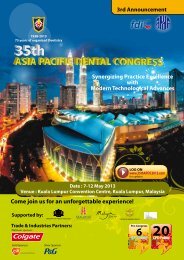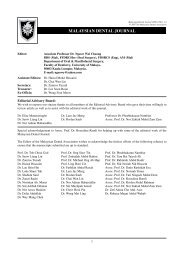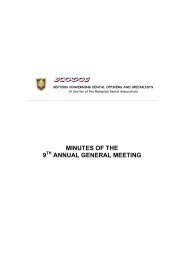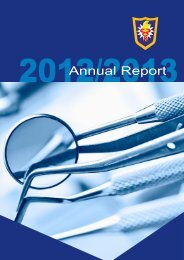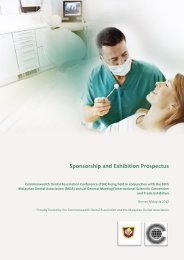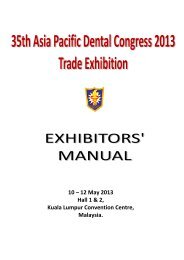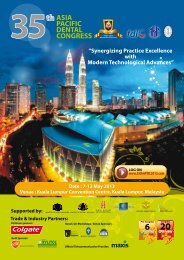PDF( 8mb) - Malaysian Dental Association
PDF( 8mb) - Malaysian Dental Association
PDF( 8mb) - Malaysian Dental Association
You also want an ePaper? Increase the reach of your titles
YUMPU automatically turns print PDFs into web optimized ePapers that Google loves.
Kathiravan / PhrabhakaranFigure 2: Flowchart to show when the cephalometricradiograph is necessary 18 .6. Oral surgeryIn case of third molars, a panoramic radiograph willprovide information about the distance of the tooth to thelower border of mandible, course and relationship of themandibular canal 24 . In other situations e.g. apicetomy orroot removal, intraoral radiography will be sufficient. Thereis no convincing evidence to support the need for routineradiographs prior normal tooth extraction 25 . Having saidthat, if there is any history of previous difficult extraction,a clinical support of unusual anatomy or surgical extractionof the tooth or if it’s close to an anatomical structure, it isprudent to take preoperative radiographs. Radiographs areessential in implantology for pre-operative planning andpost- operative assessment.7. Pregnant patients3. PeriodontologyThe diagnosis of periodontal disease depends ona clinical examination. This maybe supplemented byradiographs if they provide additional information whichcould potentially change patient management and prognosis.There is insufficient evidence to propose robust guidelineson choice of radiography for periodontal diagnosisand treatment ( i.e full mouth periapical radiographs)when a panoramic radiograph will be sufficient. Onlywhen the clinician contemplates for accurate bone levelmeasurement, the intraoral radiographs employing theparalleling technique must be taken. However existingradiographs e.g. bitewings taken for caries diagnosisshould be used in the first few instances 20 .4. EndodonticsRadiographs are essential for many aspects ofendodontic treatment 21 . Electronic apex locators are usefulin reducing the number of exposures during working lengthestimation. Preferably all intraoral radiographs are takenwith a positioning device to prevent unnecessary radiationexposure to the fingers of the patient or the operator. Thisalso ensures consistent quality of the image 22 .5. ProstheticIn the absence of any clinical signs or symptom,there is no justification for any radiographic examinationin an edentulous patient 23 . The obvious exception is ifimplant treatment is planned.<strong>Dental</strong> radiographs may be prescribed for pregnant patientsbecause the dose is very low and the beam is not directedtowards the developing fetus. There is also no need touse a lead protection apron 2,3,16,26 . However the use oflead apron continues to be advised on the grounds that itreassures the patient. A study by Hujoel et al 27 is frequentlyquoted to show the effects of dental radiographs to thedeveloping fetus. They reported that dental radiographyis associated with low birth weight. This study wasseverely critized by the dental community because of itsinadequacies. Brent 28 exposed the deficiency of that study.He also mentioned that epidemiologic and animal studiesthat involved radiation to the thyroid, pituitary and headdid not cause fetal growth retardation as a result of theseexposures.8. Patients undergoing Radiation TherapyNo special consideration applies to dental radiographsfor patient undergoing radiation therapy to head and neck.These patients are at high risk of developing dental diseaseand the radiation exposure from dental radiographs isnegligible when compared to the exposure they already arereceiving in the treatment 13 .9. ChildrenThe indication to take radiographs is similar toadults but the younger the individual, the higher is thevulnerability to radiation because of the large number ofcell divisions occurring in small children. Children alsohave a higher proportion of the bone marrow located inthe skull than adults. Smith et al. 29 have shown in thatthe calculation of risk estimates, about one induction ofmalignancy per 1000000 exposures to 5 year olds canbe expected. Leaded apron with thyroid collar should beprovided for the child and any accompanying person in thesame room as the patient during the exposure 30 .The exposure time for children under 10 years ofage can be reduced to half the exposure time required foradults; and for children between 10 to 15 years of age, theexposure time can be reduced by one third 31 . The amountof radiation is very much reduced if the current guidelines107



